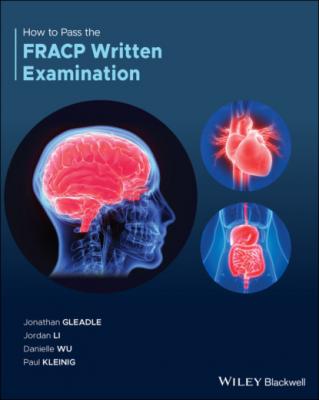How to Pass the FRACP Written Examination. Jonathan Gleadle
Читать онлайн.| Название | How to Pass the FRACP Written Examination |
|---|---|
| Автор произведения | Jonathan Gleadle |
| Жанр | Медицина |
| Серия | |
| Издательство | Медицина |
| Год выпуска | 0 |
| isbn | 9781119599548 |
MEN2A is characteriseds by MTC, phaeochromocytoma and primary hyperparathyroidism. If MEN2A is suspected, the RET gene should be examined for an underlying mutation. Autosomal dominant inheritance of MEN2 means that the offspring of an affected person has a 50% chance of inheriting the mutated gene. Identification of the underlying genetic mutation also allows predictive testing in relatives, monitoring for early detection of disease in mutation carriers, and reassurance for non‐carriers.
Von Hippel‐Lindau (VHL) gene mutation is associated with renal cell cancer, phaeochromocytoma, retinal angioma and haemangioblastoma.
McDonnell J, Gild M, Clifton‐Bligh R, Robinson B. Multiple endocrine neoplasia: an update. Internal Medicine Journal. 2019;49(8):954–961.
https://onlinelibrary.wiley.com/doi/full/10.1111/imj.14394
16. Answer: D
Maturity‐onset diabetes of the young (MODY) is a group of inherited, non‐autoimmune diabetes which usually present in adolescence or young adulthood. It is caused by single gene mutations related to beta cell development, regulation, and function. These defects lead to impaired glucose sensing and insulin release. MODY should be suspected in patients with early‐onset diabetes in adolescence or young adulthood (typically age <35 years). They usually have atypical features for both type 1 and 2 diabetes.
Features atypical for type 1 diabetes:
Absence of pancreatic islet autoantibodies
Evidence of endogenous insulin production
Measurable C‐peptide in the presence of hyperglycemia
Low insulin requirement for treatment (<0.5 U/kg/day)
Lack of ketoacidosis when insulin is omitted from treatment.
Features atypical for type 2 diabetes:
Onset of diabetes before age 45 years
Lack of obesity (unless south‐east Asian ethnicity, where type 2 diabetes occurs at lower BMIs)
Normal triglyceride levels and/or HDL‐C
Mild, stable fasting hyperglycemia that does not progress or respond appreciably to pharmacologic therapy
Extreme sensitivity to sulfonylureas.
Ketonuria is often seen in type 1 diabetes especially when the patient develops DKA. However, it can occur in MODY during other complications such as sepsis, acute myocardial infarction, excessive alcohol intake, and prolonged fasting and is therefore not a useful test to differentiate between type 1 diabetes and MODY.
There are at least 14 genes that are associated with MODY. The four most common causes of MODY are the following: GCK‐MODY (MODY2) and HNF1A‐MODY (MODY3), each accounting for 30%–60% of all MODY. While HNF4A‐MODY (MODY1) and HNF1B‐MODY (MODY5), together account for about 10% of all MODY. Approximately 20% of all MODY has been attributed to pathogenic variants in ten other genes.
Establishing a specific genetic cause of MODY can help in management of the proband, genetic counseling of family members, and medical surveillance of at‐risk family members. Moreover, in certain cases, it can also assist in optimising diabetes therapy. A MODY multigene panel that includes the 14 known MODY‐related genes and other genes of interest is most likely to identify the genetic cause of MODY at the most reasonable cost while limiting identification of variants of uncertain significance and pathogenic variants in genes that do not explain the underlying phenotype.
Bishay R, Greenfield J. A review of maturity onset diabetes of the young (MODY) and challenges in the management of glucokinase‐MODY. The Medical Journal of Australia. 2016;205(10):480–485.
17. Answer: A
Paget's disease of bone (PDB) is a non‐malignant bone disease, characterised by abnormal bone remodelling at one or multiple sites. Increased osteoblast activity leads to increased bone formation which is paired with increased osteoclast activity. Although bone formation is increased, it is disorganised, mechanically weak, and prone to deformity and fractures. Risk factors of PDB include increasing age, male sex (1.4:1), and certain ethnicities (most commonly in Caucasians). Genetic mutations in the SQSTM1 gene, are identified in up to 50% patients with a family history of PDB and in 5–10% of patients without a family history of PDB. This genetic mutation impairs the ability of p62 to bind ubiquitin, leading to activation of receptor activator of nuclear kappa B ligand (RANKL)‐induced NF‐kB which increases the osteoclast activity.
PDB most commonly affects the pelvis, spine, femur, tibia, and skull. Clinical symptoms, signs, and complications of PDB are the results of abnormal bone remodelling, enlarged bones, marrow fibrosis, and increased vascularity of bone. Depending on the affected sites, hearing loss, obstructive hydrocephalus, spinal canal stenosis, paraplegia, and high‐output cardiac failure may occur. Although, bone pain is the most commonly presenting symptom, and classically presents with pain at rest and up to 25% of patients are asymptomatic.
Serum total ALP is recommended as a first‐line screening biochemical test in combination with the liver function test to identify metabolically active PDB. Radionuclide bone scans, and targeted XX‐ray of the abdomen, tibias, skull, and facial bones are recommended to determine the extent of active bone disease in patients with PDB. X‐rays typically demonstrate a mixed pattern of osteolysis and sclerosis in keeping with disease pathophysiology.
The treatment aim in PDB is to relieve symptoms rather than achieving normalising ALP. Bisphosphonates, especially zolendronic acid, may help alleviate bone disease associated pain. Total hip or knee replacements are recommended in patients with PDB who develop osteoarthritis and in whom medical management is inadequate to manage symptoms.
Ralston S, Corral‐Gudino L, Cooper C, Francis R, Fraser W, Gennari L et al. Diagnosis and Management of Paget's Disease of Bone in Adults: A Clinical Guideline. Journal of Bone and Mineral Research. 2019;34(4):e3657.
https://asbmr.onlinelibrary.wiley.com/doi/full/10.1002/jbmr.3657
18. Answer: B
Approximately 50% of patients who have had diabetes for >25 years will develop neuropathy. The most common form of diabetic neuropathy is distal symmetric, nerve‐length‐dependent polyneuropathy. Of these, approximately 50% will have pain as a symptom of neuropathy that is painful diabetic neuropathy (PDN). The prevalence of PDN in type 2 diabetes is more than twice that seen in type 1 diabetes.
